6. The neoVI Explorer Configuration Utility
6.1. Starting and Using neoVI Explorer
This section will describe general features and the basics of using neoVI Explorer. It is the utility is used to connect to, manage and configure all of Intrepid Control Systems hardware. It is an integral part of Vehicle Spy, but for those not using Vehicle Spy software, it is also available as a stand alone application in the free ICS Hardware Installation kit
6.1.1. Starting neoVI Explorer from within Vehicle Spy
There are several ways to open neoVI Explorer from within VSpy. These are probably the two easiest, since they are accessible at all times:
Menu Item: Click the Setup menu and then select Hardware.
Hardware Setup Button: Click the button located in the main Vehicle Spy toolbar just under its menu (Figure below).

Note
neoVI Explorer cannot be launched when Vehicle Spy is online (even if in simulation mode). Attempting to do so, VSpy will display a prompt to either go offline and launch neoVI Explorer, or remain online and return to Vehicle Spy.
6.1.2. Starting neoVI Explorer as a Standalone Program
neoVI Explorer can be opened as as standalone program. The location of the shortcut to launch neoVI Explorer differs slightly between a Vehicle Spy installation and the ICS Hardware Installation kit as shown in the following screen captures.
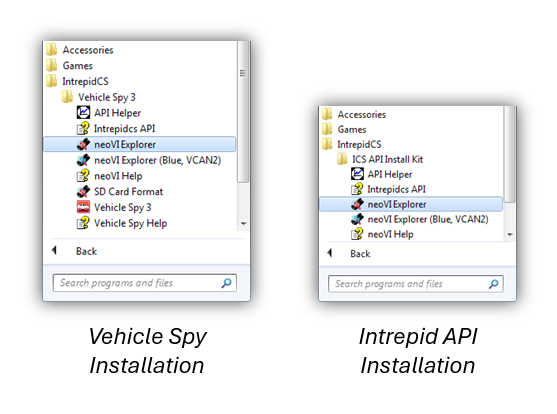
6.2. Interfacing with a device
6.2.1. Connecting to a device
When neoVI Explorer loads, it will start up with the first hardware device it can find selected in the menu pane on the left. Any connected devices should be listed here, along with its serial number. If a particular device is connected, but not seen among a list of other Intrepid devices, be sure to scroll down to look for it. If it is still not visible, this means its drivers have not been installed correctly, it is not powered properly, or there is a problem with the connection to the host computer.
To manage a device, click on its entry in the navigation pane (if it is not already highlighted) and then press the Connect button. After successfully connecting to the device, a “thumbs up” icon will be displayed next to the device’s name, and checkmarks will appear next to currently-enabled networks in the explorer area on the left. A message in the message box on the right will also read “<Your Device and Serial Number> settings have been read”. This indicates that neoVI Explorer has loaded the current settings from the unit.
The screen as a whole should appear similar to the screen shown below (but note that the device and version number shown below may be different).
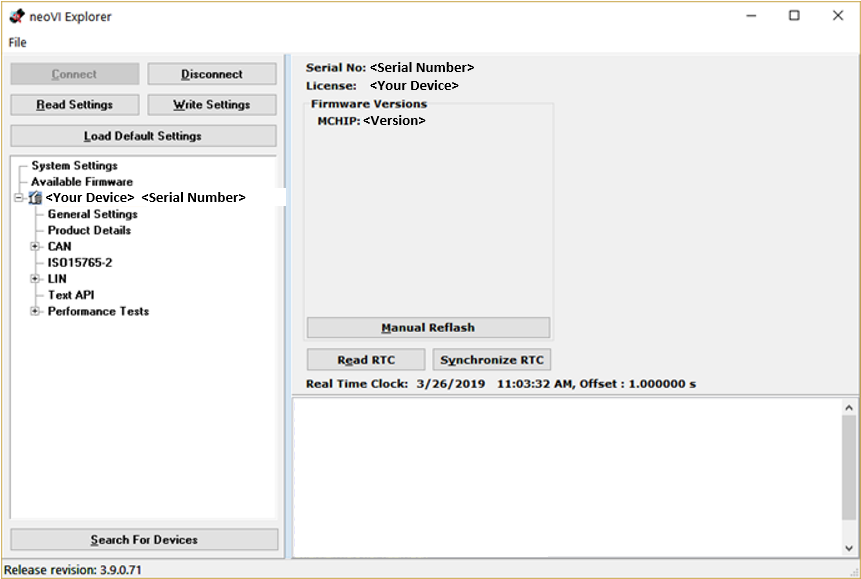
Note that this screen varies in content between Intrepid devices.
Searching for Devices
After attaching new hardware to a PC and starting neoVI Explorer, press the Search For Devices button at the bottom left of the dialog box to prompt the program to scan for new hardware to be managed.
Note
It is possible to click on various parameter groups at any time, but they will not show valid data until connected to the device. Remember also to connect to the device before making changes; Any changes made in neoVI Explorer with no device connected will be overwritten by a devices settings when it is connected.
6.2.2. Device Configuration
Writing and Reloading Settings
To avoid potential problems, neoVI Explorer will not save any changes to device parameters until instructed it to do so. This is done by pressing the Write Settings button, which will update the parameters within the firmware in the device. If unwanted changes were made, pressing the Read Settings button will reload the settings stored in the device, wiping out any modifications made in neoVI Explorer that had not yet been saved.
Reloading Device Defaults
To return all settings to factory defaults, press the Load Default Settings button. Note that pressing this button actually writes the defaults to the device first, and then reloads them automatically, so it is not necessary to also press Write Settings. The message area will display that defaults have been sent to the device and then read from it.
Disconnecting from the device
Press the Disconnect button to tell neoVI Explorer disconnect the device. This step is actually optional, because neoVI Explorer will disconnect from any connected devices when the program is closed.
Exiting neoVI Explorer
Like any Windows program, neoVI Explorer can be closed by clicking the “X” in the top right corner, or pressing the Alt+F4 key combination.
6.3. System Settings and Firmware Updates
The top two entries in the explorer window on the left side of neoVI Explorer contain system- wide settings that apply to all hardware devices, and information related to firmware updates.
6.3.1. System Settings
In the top branch of the tree in the left pane of neoVI Explorer there are several settings that can be enabled or disabled:
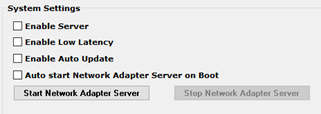
Enable Server: Turns on the neoVI Server feature, a background program that allows the hardware to be used by multiple applications at the same time.
Enable Low Latency: This is an advanced setting for applications where fast response is needed after transmission.
Enable Auto Update: When enabled, both neoVI Explorer and Vehicle Spy will automatically update firmware. If this box is not checked, firmware must be updated manually. (See below for details.)
Network Adapter Server: This is a feature that is used with Intrepid products having Ethernet ports. (It may not apply to your device.) With This feature enabled, the Ethernet ports on Intrepid hardware will enumerate as network interfaces in the operating system of the host computer. This server can be started and stopped in this window. There is also a checkbox to configure the server to start after booting of the computer.
6.3.2. Available Firmware
This is an informational page that shows which firmware versions are available in this version of neoVI Explorer for various Intrepid products. Note that some devices have multiple firmware programs that control different aspects of their operation;
6.3.3. Automatic and Manual Firmware Updates
Warning
While a device may appear to operate with incompatible firmware, proper and reliable operation cannot be guaranteed unless the version of firmware matches what is listed in Vehicle Spy
Firmware is essentially software that runs inside hardware and is required to enable the many capabilities of a device. New versions of firmware are created regularly by Intrepid’s engineers to implement new features and correct problems that have been identified.
Enable Auto Update is on by default and is recommended for most users. Each time a device connects neoVI Explorer or Vehicle Spy, the firmware will be checked, and if a newer version is available, the device will immediately be updated. If automatic updates is not enabled, it can be updated manually as needed. When new firmware is available, a red notification will be displayed on the initial connection screen, as shown below. Simply press the Manual Reflash button to update the firmware.
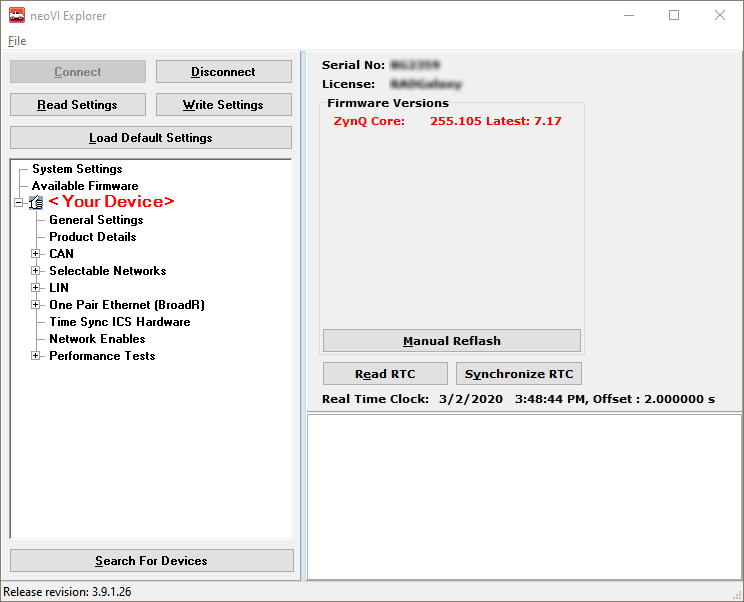
Note that this screen varies in content between Intrepid devices.
6.3.4. The Firmware Update Process
During the firmware update process, the device will be placed into bootloader mode, indicated by all LEDs on the top label flashing synchronously. Normal LED flash patterns will resume when the update is complete and the device reboots. The progress of the firmware update operation is displayed in a dialog box as shown below. A message box on the right side of neoVI Explorer will also be displayed as the firmware program is sent to the device. When the process is complete the dialog box will disappear and another message will appear in neoVI Explorer to confirm that the update has finished. If any error messages are displayed or any other problems experienced updating the device’s firmware, please contact Customer Support for assistance.

Warning
Please take heed of the warning on the firmware update dialog box: leave the device connected and powered on for the entire firmware update process to avoid possible problems with the device.
6.4. General Settings and Product Details
These two areas of the device’s parameter setup provide information about the device and can be used to perform a few basic maintenance tasks.
6.4.1. General Settings
After connecting to the device, basic information about it will be displayed in the right-hand pane of the window:
The device’s serial number.
The firmware versions currently in the device, and an indication if new firmware is available.
A message showing that the hardware license for the device was recognized.
A current readout of the device’s real-time clock.
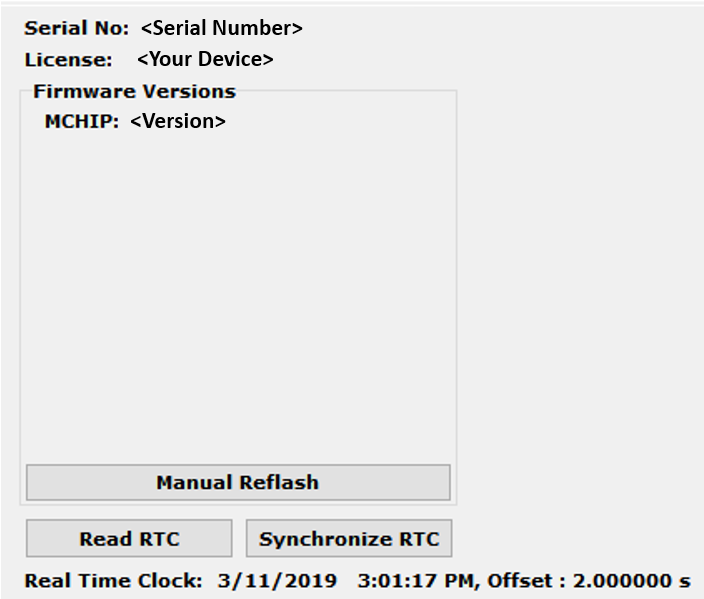
This information can be displayed again at any time by clicking the device’s name in the explorer navigation window, or the General Settings entry immediately below it.
The version(s) of the firmware for the device will be shown in black if it matches the firmware version within neoVI Explorer. If not, the current version and the newest available version will be shown in red to highlight that an update is available. (See the previous section for more about the update process.)
There are three buttons on this screen.
Manual Reflash (described in the previous section)
Read RTC button will reload the device’s internal time clock
Synchronize RTC will set the device’s clock to the same value as that of the PC.
6.4.2. Product Details
This is an informational area that provides technical data on the devices’s hardware and internal setup. This is generally only needed this if requested by Intrepid in order to facilitate support or troubleshooting. The Copy To Clipboard button can be used to copy all of the information to the Windows Clipboard to be pasted into an email or file.
6.5. RAD-Moon3 PHY Configurations
Given the RAD-Moon3 is strictly a media converter, it has minimal configuration.
6.5.1. Link Speed and Duplex
RAD-Moon3 can run at 3 different link speeds, 2.5G, 5G, and 10G. All 3 of these speeds are full duplex.
6.5.2. MultiGBASE-T1 Link Mode
The MultiGBASE-T1 PHY can be set to Master, Slave, or Auto. This determines if the RAD-Moon3 PHY or its link partner supplies the clock signal.
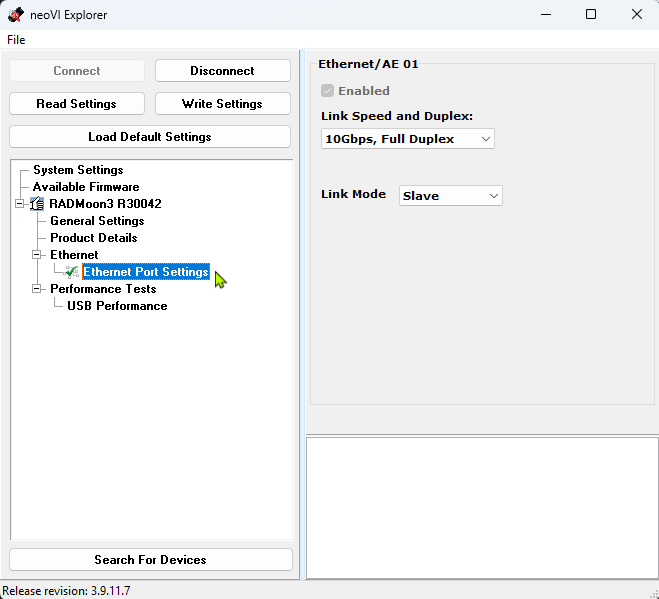
Note
The link Mode of MultiGBASE-T PHY is set to auto and cannot be statically set to master or slave. For proper operation, its link partner should also be set to auto.
6.6. PHY Firmware Updates
It is uncommon, but the firmware of one or both of the 10G PHYs may need to be updated during the life of the RAD-Moon3. If this is necessary, a file will be provided by Intrepid Control Systems that can be used to update the firmware using the following interface.
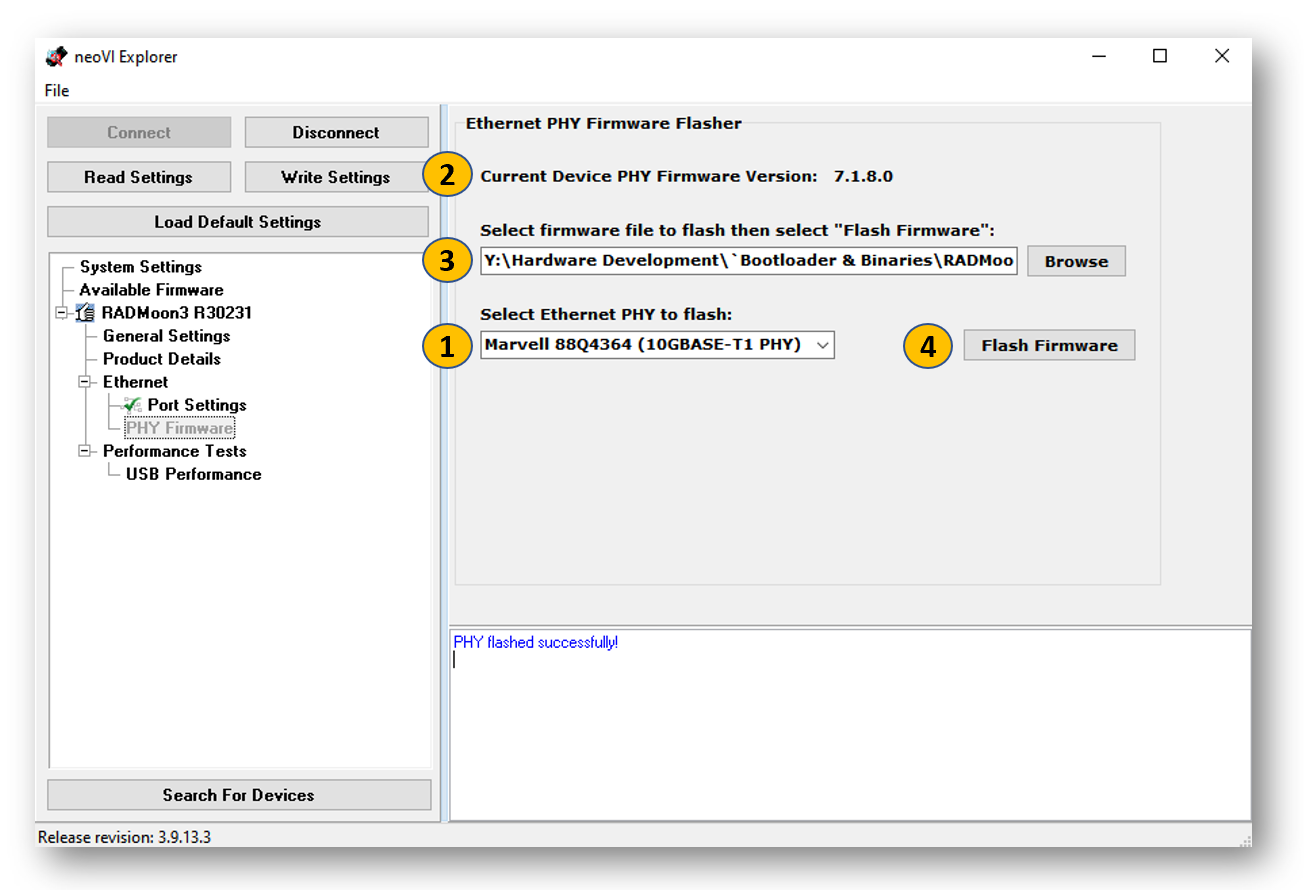
Select the PHY intended to receive the firmware update using the “Select Ethernet PHY to flash” dropdown menu.
The “Current Device PHY Firmware Version” label will update with the selected PHY’s loaded firmware version. If the PHY failed to load firmware, the version displayed will be 0.0.0.0 and an error message will be displayed in the bottom field of neoVI Explorer.
Browse to the binary file of the PHY firmware provided by Intrepid Control Systems.
Click Flash Firmware. After a successful flash, the new PHY firmware version label will be displayed and a success message will be displayed in the bottom field of neoVI Explorer.
Note
Firmware flashing may take up to 10 seconds to complete, based on the size of the binary file.